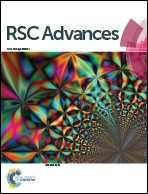Electrochemical properties of Li2MnO3 nanocrystals synthesized using a hydrothermal method†
Abstract
In this article, we report the synthesis of Li2MnO3 nanocrystals using a hydrothermal process. XRD, SEM, and TEM analyses are performed, and the electrochemical properties of the resultant nanocrystals are investigated. Adding the oxidant KMnO4 influences the phase purity, size, and shape of the Li2MnO3 nanocrystals. An amount of KMnO4 that exceeds 6% of the total Mn source enhances the formation of the pure monoclinic Li2MnO3 phase. The effect of the amount of KMnO4 on Li2MnO3 grain size can be divided into three ranges. Li2MnO3 crystals with a size around 28.7 nm and plate morphology are obtained at less than 6% of KMnO4 content; those with a size of 28.7 nm to 9.8 nm and mixed morphology of plates and rods are obtained at 6% to 11% KMnO4 content, and those with a size around 9.8 nm and rod morphology are mainly obtained at KMnO4 content exceeding 11%. Discharge capacities increase with decreasing size of Li2MnO3 nanocrystals in a linear relationship. The voltage of the first charge shows a 4.55 V plateau for Li2MnO3 nanocrystals with 28.7 nm size, becoming 4.4 V with a decrease in size to 12.2 nm, and splitting into two plateaus at around 3.8 and 4.4 V with a further decrease in size to 9.8 nm. The XRD and XANES results of the Li2MnO3 electrodes obtained after charge/discharge experiments show that smaller sizes are more beneficial in maintaining a layered structure than larger nanocrystals.


 Please wait while we load your content...
Please wait while we load your content...